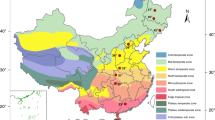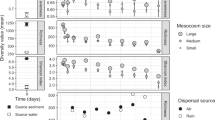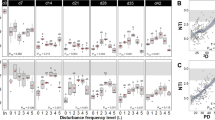Abstract
The turnover of community composition across space, β-diversity, is influenced by different assembly mechanisms, which place varying weight on local habitat factors, such as environmental conditions and species interactions, and regional factors such as dispersal and history. Several assembly mechanisms may function simultaneously; however, little is known about how their importance changes over time and why. Here, we implemented a field survey where we sampled a bacterial metacommunity consisting of 17 rock pools located at the Swedish Baltic Sea coast at 11 occasions during 1 year. We determined to which extent communities were structured by different assembly mechanisms using variation partitioning and studied changes in β-diversity across environmental gradients over time. β-Diversity was highest at times of high overall productivity and environmental heterogeneity in the metacommunity, at least partly due to species sorting, that is, selection of taxa by the prevailing environmental conditions. In contrast, dispersal-driven assembly mechanisms were primarily detected at times when β-diversity was relatively low. There were no indications for strong and persistent differences in community composition or β-diversity between permanent and temporary pools, indicating that the physical disturbance regime is of relatively minor importance. In summary, our study clearly suggests that there are temporal differences in the relative importance of different assembly mechanisms related to abiotic factors and shows that the temporal variability of those factors is important for a more complete understanding of bacterial metacommunity dynamics.
Similar content being viewed by others
Log in or create a free account to read this content
Gain free access to this article, as well as selected content from this journal and more on nature.com
or
References
Anderson TR, Hessen DO . (2005). Threshold elemental ratios for carbon versus phosphorus limitation in Daphnia. Freshwater Biol 50: 2063–2075.
Beisner BE, Peres PR, Lindstrom ES, Barnett A, Longhi ML . (2006). The role of environmental and spatial processes in structuring lake communities from bacteria to fish. Ecology 87: 2985–2991.
Blanchet FG, Legendre P, Borcard D . (2008). Forward selection of explanatory variables. Ecology 89: 2623–2632.
Borcard D, Legendre P . (2002). All-scale spatial analysis of ecological data by means of principal coordinates of neighbour matrices. Ecol Model 153: 51–68.
Borcard D, Legrende P, Drapeau P . (1992). Partialling out the spatial component of ecological variation. Ecology 73: 1045–1055.
Chalcraft DR, Cox SB, Clark C, Cleland EE, Suding KN, Weiher E et al. (2008). Scale-dependent responses of plant biodiversity to nitrogen enrichment. Ecology 89: 2165–2171.
Chase JM . (2003). Community assembly: when should history matter? Oecologia 136: 489–498.
Chase JM . (2007). Drought mediates the importance of stochastic community assembly. Proc Natl Acad Sci 104: 17430–17434.
Chase JM . (2010). Stochastic community assembly causes higher biodiversity in more productive environments. Science 328: 1388–1391.
Chase JM, Leibold MA . (2002). Spatial scale dictates the productivity-biodiversity relationship. Nature 416: 427–430.
Chase JM, Ryberg WA . (2004). Connectivity, scale-dependence, and the productivity-diversity relationship. Ecol Lett 7: 676–683.
Cottenie K . (2005). Integrating environmental and spatial processes in ecological community dynamics. Ecol Lett 8: 1175–1182.
Crump BC, Adams HE, Hobbie JE, Kling GW . (2007). Biogeography of bacterioplankton in lakes and streams of an arctic tundra catchment. Ecology 88: 1365–1378.
Crump BC, Peterson BJ, Raymond PA, Amon RMW, Rinehart A, McClelland JW et al. (2009). Circumpolar synchrony in big river bacterioplankton. Proc Natl Acad Sci 106: 21208–21212.
Dorigo U, Volatier L, Humbert JF . (2005). Molecular approaches to the assessment of biodiversity in aquatic microbial communities. Water Res 39: 2207–2218.
Drakare S, Liess A . (2010). Local factors control the community composition of cyanobacteria in lakes while heterotrophic bacteria follow a neutral model. Freshwater Biol 55: 2447–2457.
Fuhrman JA, Hewson I, Schwalbach MS, Steele JA, Brown MV, Naeem S . (2006). Annually reoccurring bacterial communities are predictable from ocean conditions. PNAS 103: 13104–13109.
Griffith DA, Peres-Neto PR . (2006). Spatial modeling in ecology: The flexibility of eigen function spatial analyses. Ecology 87: 2603–2613.
Hammer O, Harper T, Ryan PD . (2001). PAST: paleontological statistics software package for education and data analysis. Palaeontologia Electronica 4: 9pp.
Harrison S, Davies KF, Safford HD, Viers JH . (2006). Beta diversity and the scale-dependence of the productivity-diversity relationship: a test in the Californian serpentine flora. J Ecol 94: 110–117.
Hubbell SP . (2001). A unified neutral theory of biodiversity and biogeography. Princeton University Press: Princeton, NJ.
Jiang L, Patel SN . (2008). Community assembly in the presence of disturbance: a microcosm experiment. Ecology 89: 1931–1940.
Jürgens K . (1994). Impact of Daphnia on planktonic microbial food webs—a review. Mar Microb Food Webs, 1994 8: 295–324.
Kent AD, Yannarell AC, Rusak JA, Triplett EW, McMahon KD . (2007). Synchrony in aquatic microbial community dynamics. ISME J 1: 38–47.
Langenheder S, Jürgens K . (2001). Regulation of bacterial biomass and community structure by metazoan and protozoan predation. Limnol Oceanogr 46: 121–134.
Langenheder S, Ragnarsson H . (2007). The role of environmental and spatial factors for the composition of aquatic bacterial communities. Ecology 88: 2154–2161.
Langenheder S, Szekely A . (2011). Species sorting and neutral processes are both important during the initial assembly of bacterial communities. ISME J 5: 1086–1094.
Legendre P . (2008). Studying beta diversity: ecological variation partitioning by multiple regression and canonical analysis. J Plant Ecol-Uk 1: 3–8.
Legendre P, Gallagher ED . (2001). Ecologically meaningful transformations for ordination of species data. Oecologia 129: 271–280.
Leibold MA, Holyoak M, Mouquet N, Amarasekare P, Chase JM, Hoopes MF et al. (2004). The metacommunity concept: a framework for multi-scale community ecology. Ecol Lett 7: 601–613.
Lennon JT, Jones SE . (2011). Microbial seed banks: the ecological and evolutionary implications of dormancy. Nat Rev Microbiol 9: 119–130.
Lepori F, Malmqvist B . (2009). Deterministic control on community assembly peaks at intermediate levels of disturbance. Oikos 118: 471–479.
Leps J, Smilauer P . (2003). Multivariate analysis of ecological data using CANOCO. Cambridge University Press: Cambridge.
Lindström ES, Forslund M, Algesten G, Bergström AK . (2006). External control of bacterial community structure in lakes. Limnol Oceanogr 51: 339–342.
Lindström ES, Langenheder S . (2011). Minireview: local and regional factors influencing bacterial community assembly. Environ Microbiol Reports; doi:10.1111/j.1758-2229.2011.00257.x.
Logue JB, Lindström ES . (2010). Species sorting affects bacterioplankton community composition as determined by 16S rDNA and 16S rRNA fingerprints. ISME J 4: 729–738.
Mouquet N, Loreau M . (2003). Community patterns in source-sink metacommunities. Am Nat 162: 544–557.
Mouquet N, Miller TE, Daufresne T, Kneitel JM . (2006). Consequences of varying regional heterogeneity in source-sink metacommunities. Oikos 113: 481–488.
Ofiteru ID, Lunn M, Curtis TP, Wells GF, Criddle CS, Francis CA et al. (2010). Combined niche and neutral effects in a microbial wastewater treatment community. Proc Natl Acad Sci 107: 15345–15350.
Östman O, Drakare S, Kritzberg ES, Langenheder S, Logue JB, Lindström ES . (2010). Regional invariance among microbial communities. Ecol Lett 13: 118–127.
Ovreas L . (2000). Population and community level approaches for analysing microbial diversity in natural environments. Ecol Lett 3: 236–251.
Peres-Neto PR, Legendre P, Dray S, Borcard D . (2006). Variation partitioning of species data matrices: estimation and comparison of fractions. Ecology 87: 2614–2625.
Ptacnik R, Andersen T, Brettum P, Lepisto L, Willen E . (2010). Regional species pools control community saturation in lake phytoplankton. P R Soc B 277: 3755–3764.
Reynolds CS . (2009). Phytoplankton population dynamics in natural environments. In: Likens GE (ed.), Encyclopedia of Inland Waters. Elsevier: Amsterdam, pp 197–203.
Ricklefs RE . (1987). Community diversity—relative roles of local and regional processes. Science 235: 167–171.
Sloan WT, Lunn M, Woodcock S, Head IM, Nee S, Curtis TP . (2006). Quantifying the roles of immigration and chance in shaping prokaryote community structure. Environ Microbiol 8: 732–740.
Srivastava DS, Kolasa J, Bengtsson J, Gonzalez A, Lawler SP, Miller TE et al. (2004). Are natural microcosms useful model systems for ecology? Trends Ecol Evol 19: 379–384.
Van der Gucht K, Cottenie K, Muylaert K, Vloemans N, Cousin S, Declerck S et al. (2007). The power of species sorting: local factors drive bacterial community composition over a wide range of spatial scales. Proc Natl Acad Sci 104: 20404–20409.
Vanschoenwinkel B, Waterkeyn A, Jocque M, Boven L, Seaman M, Brendonck L . (2010). Species sorting in space and time-the impact of disturbance regime on community assembly in a temporary pool metacommunity. J N Am Benthol Soc 29: 1267–1278.
Verleyen E, Vyverman W, Sterken M, Hodgson DA, De Wever A, Juggins S et al. (2009). The importance of dispersal related and local factors in shaping the taxonomic structure of diatom metacommunities. Oikos 118: 1239–1249.
Woodcock S, van der Gast CJ, Bell T, Lunn M, Curtis TP, Head IM et al. (2007). Neutral assembly of bacterial communities. FEMS Microbiol Ecol 62: 171–180.
Acknowledgements
We thank Xin-Mei Feng, Johan Olofsson and Jennie Zie for help during fieldwork and analyses of samples, and Eva Lindström and three anonymous reviewers for comments on the manuscript. This work was financed by the Swedish Research Council Formas and a Marie Curie Reintegration grant to SL.
Author information
Authors and Affiliations
Corresponding author
Additional information
Supplementary Information accompanies the paper on The ISME Journal website
Rights and permissions
About this article
Cite this article
Langenheder, S., Berga, M., Östman, Ö. et al. Temporal variation of β-diversity and assembly mechanisms in a bacterial metacommunity. ISME J 6, 1107–1114 (2012). https://doi.org/10.1038/ismej.2011.177
Received:
Revised:
Accepted:
Published:
Issue date:
DOI: https://doi.org/10.1038/ismej.2011.177
Keywords
This article is cited by
-
Past community data are consistent predictors of zooplankton metacommunity structure in small reservoirs
Hydrobiologia (2024)
-
Temporal beta diversity increases with environmental variability in zooplankton floodplain communities
Limnology (2024)
-
Temporal patterns of alpha and beta diversities of microzooplankton in a eutrophic tidal river in the eastern Amazon
Limnology (2023)
-
Environmental heterogeneity and productivity drive the assemblage of benthic diatom: a case study of the Three Gorges Reservoir
Journal of Oceanology and Limnology (2023)
-
Distinct and Temporally Stable Assembly Mechanisms Shape Bacterial and Fungal Communities in Vineyard Soils
Microbial Ecology (2023)



